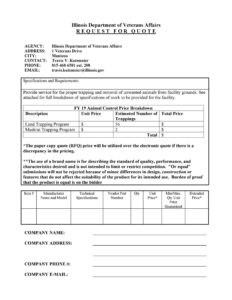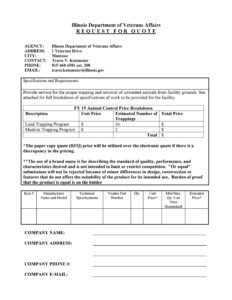Utilizing a pre-defined structure for soliciting bids offers several advantages. It saves time and resources by eliminating the need to create individual requests from scratch. Furthermore, it facilitates a fair and competitive bidding process, ultimately leading to cost savings and better value for the procuring organization. Clear, consistent communication reduces misunderstandings and potential disputes with suppliers, contributing to smoother transactions.
This article will delve deeper into the essential components, best practices for creation and utilization, and various types available to suit diverse procurement needs. Understanding these aspects is key to optimizing the procurement process and ensuring successful supplier relationships.
Key Components of a Request for Quotation Template
A comprehensive template ensures clarity and consistency in the procurement process. The following components are essential for effective solicitation of bids:
1. Company Information: Clear identification of the issuing organization, including full legal name, address, and contact details.
2. Date of Issue: Specifies the date the document was created, establishing a timeframe for responses.
3. Quotation Validity Period: Indicates the duration for which submitted pricing remains valid, allowing sufficient time for evaluation.
4. Product/Service Specifications: Detailed description of the required items or services, including quantities, units of measure, and any relevant technical specifications.
5. Delivery Requirements: Specifies desired delivery location, date, and any specific instructions regarding shipping or handling.
6. Payment Terms: Outlines accepted payment methods, payment schedules, and any applicable discounts or penalties.
7. Submission Instructions: Provides clear instructions on how and where to submit quotations, including deadlines and required formats.
8. Contact Information for Inquiries: Designates a specific point of contact for vendors to address any questions or clarifications.
Including these elements ensures a standardized and transparent process, facilitating accurate comparison of offers and efficient vendor selection. A well-structured document ultimately contributes to better procurement outcomes.
How to Create a Request for Quotation Template
Developing a standardized template for requesting quotations streamlines procurement and ensures consistency. The following steps outline the creation process:
1. Define Requirements: Clearly articulate the organization’s needs. This includes specifying the required products or services, quantities, quality standards, and any necessary technical specifications.
2. Establish Template Format: Select a suitable format, whether a word processing document, spreadsheet, or dedicated software. Ensure the chosen format allows for clear organization and easy data entry.
3. Incorporate Essential Components: Include all necessary sections, such as company information, date of issue, quotation validity period, product/service specifications, delivery requirements, payment terms, submission instructions, and contact information.
4. Ensure Clarity and Conciseness: Use precise language and avoid ambiguity. Clear communication minimizes potential misunderstandings and ensures accurate responses from vendors.
5. Review and Refine: Thoroughly review the template for completeness and accuracy before implementation. Seek input from relevant stakeholders to ensure alignment with organizational procedures.
6. Implement and Maintain: Distribute the template to relevant personnel and ensure consistent usage. Periodically review and update the template to reflect evolving business needs and best practices.
A well-designed template facilitates efficient communication with potential suppliers, leading to a more streamlined and effective procurement process. Careful planning and attention to detail are crucial for maximizing its benefits.
Standardized documents for soliciting quotations are essential tools for efficient and transparent procurement. They ensure consistency in communication with potential suppliers, facilitate accurate comparison of bids, and contribute to better purchasing decisions. Key components such as clear product specifications, delivery requirements, and payment terms are crucial for effective solicitation. Careful template design, incorporating these elements and adhering to best practices, streamlines the process and fosters positive supplier relationships.
Effective utilization of these structured forms empowers organizations to optimize procurement processes, minimize risks, and achieve cost savings. Embracing these standardized practices strengthens competitiveness and promotes long-term success in today’s dynamic marketplace.

